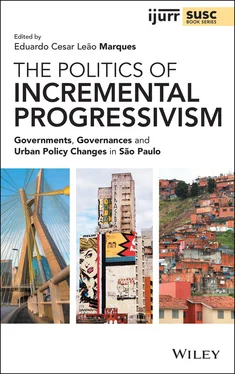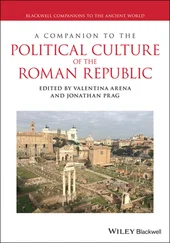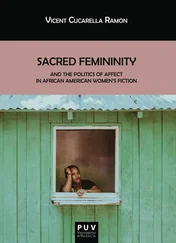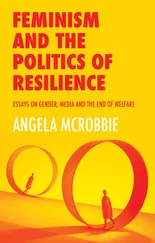Finally, in the conclusion, Eduardo Cesar Leão Marques compares the policy trajectories presented by the chapters and draws lessons for future analyses of urban politics and policies. Our conclusions challenge widely disseminated ideas about Southern city policies, usually based on the centrality of political participation, or the effects of economic and institutional macro‐processes, or combinations of clientelism, patronage, and corruption. Contrary to these notions, the São Paulo policies tended to follow incremental advancements that reduced inequalities of access, although differently by specific policies and governments, and marked by numerous conflicts.
This trajectory was a result of the slow but cumulative construction of government capacities, institutions and policy instruments within a highly competitive political environment that pushed mayors and parties to deliver more and better policies. Ideological differences between governments were central to explaining policy innovations and the differences between easy and hard redistribution policies. At the same time, policy production processes and their governance patterns help to explain the different paces of change, resilience and latency in distinct policy sectors.
In general, therefore, the trajectory of policy construction and change in São Paulo involved the same actors and mechanisms that explain policy production and urban governments elsewhere, although in locally specific combinations, as in any other large metropolis.
1 Abers, R. (2019). Bureaucratic activism: pursuing environmentalism inside the Brazilian state. Latin American Politics & Society 61 (2): 21–44.
2 Alonso, A. and Mische, A. (2017). Changing repertoires and partisan ambivalence in the new Brazilian protests. Bulletin of Latin American Research 36 (2): 144–159.
3 Andreotti, A. (ed.) (2019). Governare Milano nel nuovo millennio. Bologna: Il Mulino.
4 Arretche, M. (2012). Democracia, federalismo e centralização no Brasil. Rio de Janeiro: Ed. Fiocruz/Ed. FGV.
5 Arretche, M. (ed.) (2018). Paths of Inequality in Brazil – A Half‐Century of Changes. New York: Springer/ Ed. Unesp.
6 Arretche, M., Schlegel, R., and Ferrari, D. (2016). Preferences regarding the vertical distribution of authority in Brazil: on measurement and determinants. Publius 46 (1): 77–102.
7 Auerbach, A. (2016). Clients and communities the political economy of party network organization and development in India's urban slums. World Politics 68 (1): 111–148.
8 Auerbach, A. (2017). Neighborhood associations and the urban poor: India's slum development committees. World Development 96: 119–135.
9 Auyero, J. (2000). The logic of clientelism in Argentina: an ethnographic account. Latin American Research Review 35 (3): 55–81.
10 Baiocchi, G., Heller, P., and Silva, M. (2011). Bootstraping Democracy: Transforming Local Governance and Civil Society in Brazil. Stanford: Stanford University Press.
11 Banaszak, L. (2010). The Women's Movement Inside and Outside the State. Cambridge: Cambridge University Press.
12 Bhan, G. (2012). In the Public's Interest. Evictions, Citizenship and Inequality in Contemporary Delhi. Athens: University of Georgia Press.
13 Bussell, J. (2019). Clients and Constituents: Political Responsiveness in Patronage Democracies. Oxford: Oxford University Press.
14 Caldeira, T. (2000). The City of Walls. Los Angeles: University of California Press.
15 Caldeira, T. (2016). Peripheral urbanization: autoconstruction, transversal logics, and politics in cities of the Global South. Environment and Planning D: Society and Space 35 (1): 3–20.
16 Campbell, T. (1997). Innovations and Risk Taking: The Engine of Reform in Local Government in Latin America and the Caribbean. Washington, DC: World Bank Discussion papers.
17 Carmona, R. (2012). El debate sobre nuevos estilos de gobienrno em ciudades argentinas. Buenos Aires: Ediciones Ciccus.
18 Carrión, F. and Ponce, S. (eds.) (2015). El giro a la izquierda: los gobiernos locales de America Latina. Quito: 5ª avenida Ed.
19 Chaves, D. and Goldfrank, B. (eds.) (2004). La izquierda en la ciudad. Barcelona: Icaria ed.
20 Cleary, M. (2007). Electoral competition, participation, and government responsiveness in Mexico. American Journal of Political Science 51 (2): 283–299.
21 Coslovsky, S. (2016). Beyond bureaucracy: how prosecutors and public defenders enforce urban planning laws in São Paulo, Brazil. International Journal of Urban and Regional Research 39 (6): 1103–1119.
22 Diamond, L. and Morlino, L. (2004). The quality of democracy: an overview. Journal of Democracy 15 (4): 20–31.
23 Dropp, K. and Peskowitz, Z. (2012). Electoral security and the provision of constituency service. The Journal of Politics 74 (1): 220–234.
24 Einstein, K. and Glick, D. (2018). Mayors, partisanship, and redistribution: evidence directly from U.S. mayors. Urban Affairs Review 54 (1): 74–106.
25 Eulau, H. and Karps, P. (1977). The puzzle of representation: specifying components of responsiveness. Legislative Studies Quarterly 2 (3): 233–254.
26 Evans, P., Rueschmeyer, D., and Skocpol, T. (eds.) (1985). Bringing the State Back in. Cambridge: Cambridge University Press.
27 Faguet, J.‐P. and Pöschl, C. (2015). Is Decentralization Good for Development? Perspectives from Academics and Policy Makers. Oxford: Oxford University Press.
28 Fairfield, T. and Garay, C. (2017). Redistribution under the right in Latin America: electoral competition and organized actors in policymaking. Comparative Political Studies 50 (14): 1871–1906.
29 Ferman, B. (1985). Governing the Ungovernable City: Political Skill, Leadership and the Modern Mayor. Philadelphia: Temple University Press.
30 Figueiredo, A. and Limongi, F. (1999). Executivo e Legislativo na nova ordem constitucional. Rio de Janeiro: FGV.
31 Fiorina, M. (1989). Congress: Keystone of the Washington Establishment. New Haven, CT: Yale University Press.
32 França, D. (2016). Inequalities and residential segregation by race and class. In: São Paulo in the Twenty‐First Century Spaces, Heterogeneities, Inequalities (ed. E. Marques), 196–213. New York: Routledge.
33 Gilbert, A. (2013). How to help, and how not to help, the poor in the megacities of the south. City 17 (5): 628–635.
34 Gilbert, A. and Gugler, J. (1982). Cities, Poverty, and Development: Urbanization in the Third World. Oxford: Oxford University Press.
35 Giraudy, A., Moncada, E., and Snyder, R. (eds.) (2019). Inside Countries: Subnational Research in Comparative Politics. New York: Cambridge University Press.
36 Goldfrank, B. (2011). Deepening Local Democracy in Latin American: Participation, Decentralization and the Left. Philadelphia: University of Pennsylvania Press.
37 Gordon, I. and Travers, T. (2010). London: planning the ungovernable city. City, Culture and Society 1 (2): 49–55.
38 Gurza Lavalle, A. (2018). Councils, associations, and inequality. In: Paths of Inequality in Brazil – a Half‐Century of Changes (ed. M. Arretche), 25–44. New York: Springer/Ed. Unesp.
39 Gurza Lavalle, A., Carlos, E., Dowbor, M., and Szwako, J. (2019). Movimentos sociais, institucionalização e domínios de agência. In: Movimentos sociais e institucionalização: políticas sociais, raça e gênero no Brasil pós‐transição (eds. A. Gurza Lavalle, E. Carlos, M. Dowbor and J. Szwako), 21–87. Rio de Janeiro: Ed. Uerj.
40 Hajnal, Z. and Trounstine, J. (2017). Who or what governs? The effects of economics, politics, institutions, and needs on local spending. American Politics Research 38 (6): 1130–1163.
41 Herrera, V. (2017). From participatory promises to partisan capture: local democratic transitions and Mexican water politics. Comparative Politics 38 (4): 479–499.
Читать дальше












